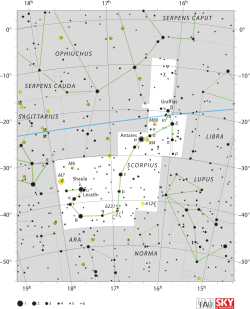罚一
| 观测资料 历元 J2000.0 | |
|---|---|
| 星座 | 天蝎座 |
| 星官 | 罚 |
| 赤经 | 16h 15m 37.26946s[1] |
| 赤纬 | –08° 22′ 09.9870″[1] |
| 视星等(V) | 5.503[2] |
| 特性 | |
| 光谱分类 | G2 Va |
| U−B 色指数 | +0.18[3] |
| B−V 色指数 | +0.64[3] |
| 变星类型 | Sun-like[4] |
| 天体测定 | |
| 径向速度 (Rv) | +11.6[2] km/s |
| 自行 (μ) | 赤经:230.77[1] mas/yr 赤纬:-495.53[1] mas/yr |
| 视差 (π) | 71.94 ± 0.37[1] mas |
| 距离 | 45.3 ± 0.2 ly (13.90 ± 0.07 pc) |
| 绝对星等 (MV) | 4.77[2] |
| 详细资料 | |
| 质量 | 1.02 ± 0.03[5] M☉ |
| 半径 | 1.010 ± 0.009[5] R☉ |
| 表面重力 (log g) | 4.45[6] |
| 亮度 | 1.058 ± 0.028[7] L☉ |
| 温度 | 5,433 ± 69[7] K |
| 金属量 [Fe/H] | 0.04[6] dex |
| 自转 | 22.7 ± 0.5[8] |
| 年龄 | 4.1–5.3[9] Gyr |
| 其他命名 | |
| 参考资料库 | |
| SIMBAD | 资料 |
| 系外行星资料库 | 资料 |
罚一 (天蝎座18) 是一颗距离地球45.3光年(13.9秒差距) 的孤独恒星,他的位置在天蝎座北方的边界处。他的视星等是5.5I[2],它有足够的亮度可以在城市以外的地区以肉眼直接看见。
罚一有许多物理上的属性与太阳相似。Cayrel de Strobel (1996) 在她审视恒星时将它列入类似太阳的恒星[10],并且Porto de Mello和da Silva (1997) 确定它为孪生太阳[11]。因此,有些科学家相信在其附近有生命存在的前景看好。然而,迄今尚未发现这颗恒星有行星环绕著。
特征
[编辑]罚一是一颗主序星,光谱和光度分类为G2Va[11],光度分类为V指出它在核心地区经由氢的核融合产生能量。Sousa et al. (2008) 发现它的金属量大约是太阳的1.1倍,这意味著除了氢或氦之外的元素丰度比太阳多了10% [6][12]。它的半径,由Bazot et al. (2011) 使用干涉仪测量,是太阳半径的101%。结合星震学测量的结果,估计这颗恒星的质量是太阳质量的102 %[5]。测量这颗恒星表面的有效温度是5,433K,因此他的辐射是太阳的106%[7]。他的热使这颗恒星事发出黄色色调的白炙G型恒星[13]。
依据Lockwood (2002),它瞬时光度的行为非常像太阳[14]。在其整个活动周期,其亮度的变化只有0.09%,与目前太阳周期的光度变化大约相同[15]。使用塞曼-都卜勒成像技术,Petit et al. (2008)已经测量到它表面的磁场,显示其强度和几何非常类似于太阳的磁场[16]。估计它的活动周期大约是7年[4],这远短于太阳,但是它整体的色球活动水准明显的比太阳高[15][17]。太阳相似,它有高温的冕,温度范围在150-200万K;X射线的发光度是8 ± 1.5 ergs s–1[8]。
虽然罚一整体的金属量只比太阳太阳略高一些,但它的锂丰度大约是3倍;由于这个原因,Meléndez和Ramírez (2007)建议罚一可以称为准太阳孪生,以与类太阳恒星有所区隔 (像是HIP56948),它的所有参数,在误差范围之内,都与太阳完全吻合[18]。
在2003年9月,罚一被来自亚利桑纳土桑亚利桑那大学的太空生物学家玛格丽特·特布林,基于它对适居恒星表清单的分析,选为最有希望培育生命的恒星。这是一颗孤独的恒星,截至2005年,经由径向速度的测量,尚未发现有行星环绕著它的迹象[19]。这颗恒星也没有过量的红外线辐射,不足以建议它有松散的星周物质,像是岩屑盘的存在[20]。
参考资料
[编辑]- ^ 1.0 1.1 1.2 1.3 1.4 van Leeuwen, F., Validation of the new Hipparcos reduction, Astronomy and Astrophysics, November 2007, 474 (2): 653–664, Bibcode:2007A&A...474..653V, arXiv:0708.1752
 , doi:10.1051/0004-6361:20078357
, doi:10.1051/0004-6361:20078357
- ^ 2.0 2.1 2.2 2.3 Nordström, B.; et al, The Geneva-Copenhagen survey of the Solar neighbourhood. Ages, metallicities, and kinematic properties of ˜14 000 F and G dwarfs, Astronomy and Astrophysics, May 2004, 418: 989–1019, Bibcode:2004A&A...418..989N, arXiv:astro-ph/0405198
 , doi:10.1051/0004-6361:20035959
, doi:10.1051/0004-6361:20035959
- ^ 3.0 3.1 3.2 18 Sco -- Variable Star, SIMBAD (Centre de Données astronomiques de Strasbourg), [2011-10-13], (原始内容存档于2020-11-07) The ubv information is per Compilation of Eggen's UBV data, transformed to UBV (unpublished) 1986. See the Measurements section.
- ^ 4.0 4.1 Hall, Jeffrey C.; et al, The Activity and Variability of the Sun and Sun-Like Stars. II. Contemporaneous Photometry and Spectroscopy of Bright Solar Analogs, The Astronomical Journal, July 2009, 138 (1): 312–322, Bibcode:2009AJ....138..312H, doi:10.1088/0004-6256/138/1/312
- ^ 5.0 5.1 5.2 Bazot, M.; et al, The radius and mass of the close solar twin 18 Scorpii derived from asteroseismology and interferometry, Astronomy and Astrophysics, February 2011, 526, Bibcode:2011A&A...526L...4B, doi:10.1051/0004-6361/201015679
- ^ 6.0 6.1 6.2 Sousa, S. G.; et al, Spectroscopic parameters for 451 stars in the HARPS GTO planet search program. Stellar [Fe/H] and the frequency of exo-Neptunes, Astronomy and Astrophysics, August 2008, 487 (1): 373–381, Bibcode:2008A&A...487..373S, arXiv:0805.4826
 , doi:10.1051/0004-6361:200809698
, doi:10.1051/0004-6361:200809698
- ^ 7.0 7.1 7.2 Boyajian, Tabetha S.; et al, Stellar Diameters and Temperatures. I. Main-sequence A, F, and G Stars, The Astrophysical Journal, February 2012, 746 (1): 101, Bibcode:2012ApJ...746..101B, arXiv:1112.3316
 , doi:10.1088/0004-637X/746/1/101. See Table 10.
, doi:10.1088/0004-637X/746/1/101. See Table 10.
- ^ 8.0 8.1 Coughlin, Jared; et al, The Night Time Sun: X-Ray Observations of the Solar Twin 18 Scorpii, Bulletin of the American Astronomical Society, January 2010, 42: 333, Bibcode:2010AAS...21542417C
- ^ Mamajek, Eric E.; Hillenbrand, Lynne A., Improved Age Estimation for Solar-Type Dwarfs Using Activity-Rotation Diagnostics, The Astrophysical Journal, 2008, 687 (2): 1264–1293, Bibcode:2008ApJ...687.1264M, arXiv:0807.1686
 , doi:10.1086/591785
, doi:10.1086/591785
- ^ Cayrel de Strobel, G., Stars Resembling the Sun, The Astronomy and Astrophysics Review, 1996, 7 (3): 243–288, Bibcode:1996A&ARv...7..243C, doi:10.1007/s001590050006
- ^ 11.0 11.1 Porto de Mello, G. F.; da Silva, L., HR 6060: The Closest Ever Solar Twin?, The Astrophysical Journal, 1997, 482 (2): L89–L92, Bibcode:1997ApJ...482L..89P, doi:10.1086/310693
- ^ A metallicity of [Fe/H] = 1.04 dex indicates that the star has 100.04 = 1.096, or 110% of the abundance of elements heavier than helium, compared to the Sun.
- ^ The Colour of Stars, Australia Telescope, Outreach and Education (Commonwealth Scientific and Industrial Research Organisation), December 21, 2004 [2012-01-16], (原始内容存档于2012-03-10)
- ^ Lockwood, G. W.; et al, Gauging the Sun: Comparative photometric and magnetic activity measurements of sunlike stars, 1984-2001 (PDF), Bulletin of the American Astronomical Society, May 2002, 34: 651, Bibcode:2002AAS...200.0709L, (原始内容 (PDF)存档于2006-09-05)
- ^ 15.0 15.1 Hall, J. C.; Lockwood, G. W., The Sun-Like Activity of the Solar Twin 18 Scorpii, The Astronomical Journal, 2007, 133 (5): 2206–2008, Bibcode:2007AJ....133.2206H, arXiv:astro-ph/0703450
 , doi:10.1086/513195
, doi:10.1086/513195
- ^ Petit, P.; et al, Toroidal versus poloidal magnetic fields in Sun-like stars: a rotation threshold, Monthly Notices of the Royal Astronomical Society, 2008, 388 (1): 80, Bibcode:2008MNRAS.388...80P, arXiv:0804.1290
 , doi:10.1111/j.1365-2966.2008.13411.x
, doi:10.1111/j.1365-2966.2008.13411.x
- ^ Hall, Jeffrey C.; Lockwood, G. W., Evidence of a Pronounced Activity Cycle in the Solar Twin 18 Scorpii, The Astrophysical Journal, 2000, 545 (2): L43–L45, Bibcode:2000ApJ...545L..43H, doi:10.1086/317331
- ^ Meléndez, J.; Ramírez, I., HIP 56948: A Solar Twin with a Low Lithium Abundance, The Astrophysical Journal, 2007, 669 (2): L89–L92, Bibcode:2007ApJ...669L..89M, arXiv:0709.4290
 , doi:10.1086/523942
, doi:10.1086/523942
- ^ Marcy, Geoffrey W.; et al, Five New Extrasolar Planets, The Astrophysical Journal, 2005, 619 (1): 570–584, Bibcode:2005ApJ...619..570M, doi:10.1086/426384
- ^ Lawler, S. M.; et al, Explorations Beyond the Snow Line: Spitzer/IRS Spectra of Debris Disks Around Solar-type Stars, The Astrophysical Journal, November 2009, 705 (1): 89–111, Bibcode:2009ApJ...705...89L, arXiv:0909.0058
 , doi:10.1088/0004-637X/705/1/89
, doi:10.1088/0004-637X/705/1/89
外部链接
[编辑]- Kaler, James B., 18 Scorpii, Stars (University of Illinois), [2012-03-06], (原始内容存档于2021-04-15)
- NASA article on 18 Scorpii(页面存档备份,存于互联网档案馆)
- 18 Scorpii entry in the stellar database (页面存档备份,存于互联网档案馆)
- Astronomers Measure Sun-Like Brightness Changes of the Solar Twin, 18 Scorpii

